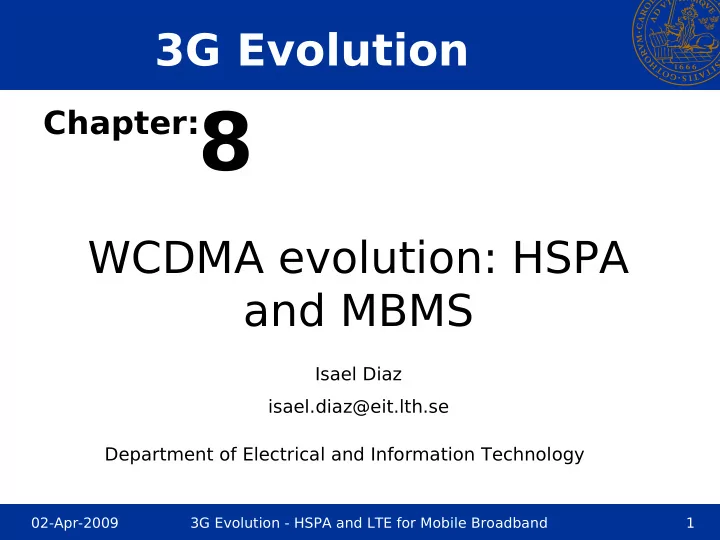

3G Evolution Chapter: 8 WCDMA evolution: HSPA and MBMS Isael Diaz isael.diaz@eit.lth.se Department of Electrical and Information Technology 02-Apr-2009 3G Evolution - HSPA and LTE for Mobile Broadband 1
Outline • Evolution • HSPA and MBMS • Multiple Access • Direct Sequence Spread Spectrum • Network Architecture • Protocol Architecture • Physical Layer • Channelization Codes • Asynchronous Operation • Power Control • Soft handover • Packet Data Session 02-Apr-2009 3G Evolution - HSPA and LTE for Mobile Broadband 2
WCDMA: Evolution - MBMS – Multimedia broadcast Multicast Services - Introduction of improved broadcast servicios ('Mobile TV') Enhanced uplink – improved Uplink packet-data support - Reduced delays - 5.74 Mbps peak data rate - ~2xR99 capacity HSDPA -improved downlink - MIMO and higher-order modulation packet-data support - 28 Mbps DL peak data rate -Reduced delays - 11 Mbps UL peak data rate - 14Mbits/s peak data rate - Continuous Packet Connectivity ~3xR99 capacity - 'Always on' user experience *Image inspired “3G evolution HSPA and LTE Mobile Broadband” 02-Apr-2009 3G Evolution - HSPA and LTE for Mobile Broadband 3
WCDMA: HSPA and MBMS • HSPA (More details in further chapters) – Evolution of WCDMA – 14Mbps in DL – 5.8Mbps in UL • MBMS (Further explanation in Chapter 12) – Enables broadcasting services such as TV, radio, traffic reports, etc. 02-Apr-2009 3G Evolution - HSPA and LTE for Mobile Broadband 4
WCDMA: Multiple Access • CDMA – Multiple users share physical medium in time and frequency – Based on interference robustness – All user have same carrier frequency – Each user has a unique code – Benefits from multi path environment *Image courtesy of Ericsson AB 02-Apr-2009 3G Evolution - HSPA and LTE for Mobile Broadband 5
WCDMA: DS-SS • Direct Sequence Spread Spectrum – Same carrier frequency – Looks like noise if correct spreading code is not used – To recover the transmitter signal the receiver needs the spreading code *Image courtesy of Ericsson AB 02-Apr-2009 3G Evolution - HSPA and LTE for Mobile Broadband 6
WCDMA: Network Architecture • An UE communicates with one or more NodeBs • NodeB is responsible for – FEC – Modulation – Spreading • RNC in charge of – Control of one or more NodeBs – Charge of call set up – QoS – Radio resources (ARQ) *Image inspired “3G evolution HSPA and LTE Mobile Broadband” 02-Apr-2009 3G Evolution - HSPA and LTE for Mobile Broadband 7
WCDMA: Protocol Architecture • PDCP – Performs header compression • RLC – IP packet segmentation – ARQ protocol • MAC – Interfaces logical channels and transport channels • PHY – Coding, spreading, modulation, etc. *Image inspired “3G evolution HSPA and LTE Mobile Broadband” 02-Apr-2009 3G Evolution - HSPA and LTE for Mobile Broadband 8
WCDMA: Physical Layer • 3.84Mchip/s • Turbo coder 1/3 • QPSK for DL • BPSK for UL • Every specific spreading codes corresponds to a each physical channel • CPICH reference channel for DL *Image inspired “3G evolution HSPA and LTE Mobile Broadband” 02-Apr-2009 3G Evolution - HSPA and LTE for Mobile Broadband 9
WCDMA: Channelization Codes (OVSF) • Mutual orthogonality • OVSF must be selected from different branches • Different OVSF provide different spreading factors • Different Spreading factors provide different data-rates • Spreading factor is selected by the MAC layer • Some channelization codes are pre-allocated (CPICH, cell specific information, etc) *Image inspired “3G evolution HSPA and LTE Mobile Broadband” 02-Apr-2009 3G Evolution - HSPA and LTE for Mobile Broadband 10
WCDMA: Asynchronous Operation • WCDMA does not require inter-base station synchronization (no GPS dependency) • Advantage – Reduced deployment efforts • Drawback – BS interference to other BS – More challenging cell-search procedure – Complicated handover implementation 02-Apr-2009 3G Evolution - HSPA and LTE for Mobile Broadband 11
WCDMA: Power control • Formally named fast closed/closed loop power control • Attempts to avoid the near-far problem by: – measuring the UE signal 1500 times/sec – Regulating the transmission power of both UE and BS 02-Apr-2009 3G Evolution - HSPA and LTE for Mobile Broadband 12
WCDMA: Soft handover • The UE communicates with multiple cells simultaneously (active set) – The RNC determines based on measurements which cells are part of the active set – Provides diversity against fast fading in both DL and UL – Typically a rake receiver is used – “Or of the downs” ensures that average power is kept low *Image is courtesy of Ericsson AB 02-Apr-2009 3G Evolution - HSPA and LTE for Mobile Broadband 13
WCDMA: Packet Data Session • UE: Cell search (connection request) • RNC: Channelization codes available • RNC: Interference level • RNC Connection established • Transmission power varies according to traffic pattern *Image inspired Ove Edfors, lecture on WCDMA 02-Apr-2009 3G Evolution - HSPA and LTE for Mobile Broadband 14
WCDMA: Summary • HSPA is the evolution of WCDMA • Spread Spectrum • A major milestone in mobile telecommunication • Flexible radio interface • Transmission power dependent on traffic pattern • Sensitive to inter-cell interference • Sensitive to near-far problem 02-Apr-2009 3G Evolution - HSPA and LTE for Mobile Broadband 15
• Thank you for your attention 02-Apr-2009 3G Evolution - HSPA and LTE for Mobile Broadband 16
Recommend
More recommend